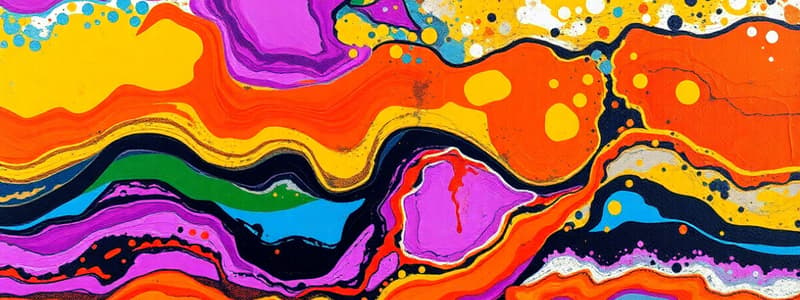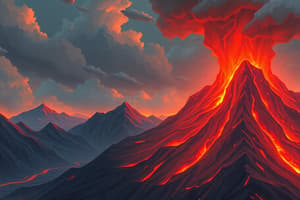Podcast
Questions and Answers
What are igneous rocks?
What are igneous rocks?
Rocks that formed from a melt that cooled (other melted rocks)
What are intrusive rocks called?
What are intrusive rocks called?
Magma
What are extrusive rocks called?
What are extrusive rocks called?
Lava
Where is magma found?
Where is magma found?
Where is lava found?
Where is lava found?
Which of these minerals are found in felsic magma?
Which of these minerals are found in felsic magma?
What is the silica content of felsic magma?
What is the silica content of felsic magma?
What is the silica content of intermediate magma?
What is the silica content of intermediate magma?
What is the silica content of mafic magma?
What is the silica content of mafic magma?
What is the silica content of ultramafic magma?
What is the silica content of ultramafic magma?
What happens to the concentration of ferromagnesian silicates as silica content decreases?
What happens to the concentration of ferromagnesian silicates as silica content decreases?
Define geotherm.
Define geotherm.
What are some examples of geological features associated with geotherms?
What are some examples of geological features associated with geotherms?
What does Bowen's reaction series describe?
What does Bowen's reaction series describe?
Describe the continuous branch of Bowen's reaction series.
Describe the continuous branch of Bowen's reaction series.
Describe the discontinuous branch of Bowen's reaction series.
Describe the discontinuous branch of Bowen's reaction series.
Explain the difference in viscosity between magma with high silica content and magma with low silica content.
Explain the difference in viscosity between magma with high silica content and magma with low silica content.
Which of the following are processes of magma formation in the Earth?
Which of the following are processes of magma formation in the Earth?
Describe decompression as a process of magma formation.
Describe decompression as a process of magma formation.
Describe the addition of volatiles as a process of magma formation.
Describe the addition of volatiles as a process of magma formation.
Describe the transfer of heat from adjacent magma or very hot rocks as a process of magma formation.
Describe the transfer of heat from adjacent magma or very hot rocks as a process of magma formation.
Define pluton.
Define pluton.
Define batholith.
Define batholith.
Define laccolith.
Define laccolith.
Define dike.
Define dike.
Define sill.
Define sill.
What is a supervolcano?
What is a supervolcano?
What is the VEI and what does a magnitude 8 on the VEI represent?
What is the VEI and what does a magnitude 8 on the VEI represent?
Give an example of a supervolcano?
Give an example of a supervolcano?
What are hot-spot volcanoes?
What are hot-spot volcanoes?
Where do hot-spot volcanoes occur?
Where do hot-spot volcanoes occur?
What does a hotspot track indicate?
What does a hotspot track indicate?
Which of the following are forms of subaerial volcanoes?
Which of the following are forms of subaerial volcanoes?
Describe the characteristics of stratovolcanoes.
Describe the characteristics of stratovolcanoes.
Describe the characteristics of cinder cones.
Describe the characteristics of cinder cones.
Describe the characteristics of shield volcanoes.
Describe the characteristics of shield volcanoes.
Describe the characteristics of pahoehoe lava flows.
Describe the characteristics of pahoehoe lava flows.
Describe the characteristics of a'a' lava flows.
Describe the characteristics of a'a' lava flows.
Which of the following are examples of pyroclastic debris?
Which of the following are examples of pyroclastic debris?
What are pillow lavas?
What are pillow lavas?
Which of the following types of lava has a higher silica content?
Which of the following types of lava has a higher silica content?
Which transport medium carries the largest particles?
Which transport medium carries the largest particles?
Define weathering.
Define weathering.
Which of the following are types of physical weathering?
Which of the following are types of physical weathering?
Which of the following are types of chemical weathering?
Which of the following are types of chemical weathering?
Define biological weathering.
Define biological weathering.
Define erosion.
Define erosion.
Define transportation.
Define transportation.
What is the difference between lithification and diagenesis?
What is the difference between lithification and diagenesis?
How do you classify chemical and biochemical sedimentary rocks?
How do you classify chemical and biochemical sedimentary rocks?
Define transgression.
Define transgression.
Define regression.
Define regression.
What is the difference between metamorphism and diagenesis?
What is the difference between metamorphism and diagenesis?
Give examples of foliation in metamorphic rocks.
Give examples of foliation in metamorphic rocks.
What is the difference between regional dynamothermal metamorphism and thermal or contact metamorphism?
What is the difference between regional dynamothermal metamorphism and thermal or contact metamorphism?
Define protolith.
Define protolith.
A protolith may belong to any of the primary rock types.
A protolith may belong to any of the primary rock types.
What are the pressure and temperature conditions for the formation of a blueschist?
What are the pressure and temperature conditions for the formation of a blueschist?
Define aureole.
Define aureole.
Describe the characteristics of non-foliated metamorphic rocks.
Describe the characteristics of non-foliated metamorphic rocks.
Which of the following are examples of non-foliated metamorphic rocks?
Which of the following are examples of non-foliated metamorphic rocks?
Flashcards
Igneous Rocks
Igneous Rocks
Rocks formed from cooled melt (magma or lava).
Magma
Magma
Molten rock beneath the Earth's surface.
Lava
Lava
Molten rock above the Earth's surface.
Felsic Magma
Felsic Magma
Signup and view all the flashcards
Intermediate Magma
Intermediate Magma
Signup and view all the flashcards
Ultramafic Magma
Ultramafic Magma
Signup and view all the flashcards
Mafic Magma
Mafic Magma
Signup and view all the flashcards
Pluton
Pluton
Signup and view all the flashcards
Laccolith
Laccolith
Signup and view all the flashcards
Dike
Dike
Signup and view all the flashcards
Sill
Sill
Signup and view all the flashcards
Supervolcano
Supervolcano
Signup and view all the flashcards
Hot-spot Volcanoes
Hot-spot Volcanoes
Signup and view all the flashcards
Hot-spot track
Hot-spot track
Signup and view all the flashcards
Stratovolcano
Stratovolcano
Signup and view all the flashcards
Cinder Cone
Cinder Cone
Signup and view all the flashcards
Shield Volcano
Shield Volcano
Signup and view all the flashcards
Pahoehoe
Pahoehoe
Signup and view all the flashcards
‘A’a’
‘A’a’
Signup and view all the flashcards
Weathering
Weathering
Signup and view all the flashcards
Erosion
Erosion
Signup and view all the flashcards
Transportation
Transportation
Signup and view all the flashcards
Lithification
Lithification
Signup and view all the flashcards
Diagenesis
Diagenesis
Signup and view all the flashcards
Study Notes
Igneous Rocks
- Igneous rocks form from a melted substance that cools.
- Magma is intrusive/plutonic rock.
- Lava is extrusive/volcanic rock.
- Magma is underground, lava is above ground.
- Felsic magma has high silica content (>65%).
- Intermediate magma has 53-65% silica.
- Ultramafic magma has <45% silica.
- Mafic magma has 45-52% silica.
- As silica content lowers, ferromagnesian silicates rise.
Geotherm
- A line or surface depicting equal temperature points (e.g., hot springs, geysers).
Bowen's Reaction Series
- Describes the sequence minerals crystallize/melt at various temperatures.
- Continuous branch relates to plagioclase feldspar evolution (calcium to sodium-rich).
- Discontinuous branch relates to olivine, pyroxene, amphibole, and biotite mica formation.
Magma and Viscosity
- Magma with high silica content has higher viscosity than magma with low silica content.
Magma Formation
- Three processes: decompression, addition of volatiles, transfer of heat.
- Decompression: Rock melts at lower pressure (e.g., at divergent plate boundaries).
- Addition of volatiles: Water vapor lowers melting point, allowing melting at lower temperatures.
Plutons
- Pluton: Deep-seated intrusions.
- Batholith: >100km^2, largest pluton.
- Laccolith: Mushroom-shaped pluton.
- Dike: Tabular, discordant pluton.
- Sill: Tabular, concordant pluton.
Supervolcanoes
- Supervolcano - large volcanic center with VEI 8 eruptions.
- Example: Yellowstone Caldera.
Hotspot Volcanoes
- Hotspots - areas of the Earth's mantle with plumes, creating volcanoes.
Hotspot Tracks
- Chain of volcanoes formed as a tectonic plate moves over a hotspot plume.
Subaerial Volcanoes (forms)
- Stratovolcanoes: Steep sides, alternating lava and ash layers.
- Cinder cones: Small, steep-sided cones from solidified lava fragments (cinders/scoria).
- Shield volcanoes: Gently sloping sides, formed by runny lava.
- Differences between Pahoehoe and ‘a’a’ lava flows are in surface texture.
Volcanic Debris
- Ash: <2mm, smallest particle.
- Lapilli: 2-64mm.
- Bomb: >64mm.
Pillow Lavas
- Form when lava erupts underwater and cools quickly.
Lava Type Differences
- Basaltic lava - low silica content.
- Rhyolitic lava - high silica content.
Weathering, Erosion, and Transportation
- Weathering: Breakdown of rocks in place (physical and chemical).
- Erosion: Removal and transportation of rock material.
- Transportation: Process of moving sediment (e.g., water, wind, ice).
Lithification and Diagenesis
- Lithification: Compaction and cementation of sediments into rock.
- Diagenesis: Chemical, biological, and physical processes after sediment deposition.
Classifying Sedimentary Rocks (chemical and biochemical)
- Classified by their mineral composition, rather than grain size, unlike clastic rocks.
Transgression and Regression
- Transgression: Sea level rises, flooding land.
- Regression: Sea level falls, exposing land.
Metamorphism and Diagenesis
- Metamorphism: Rocks transform into denser, more compact rocks with different mineral compositions.
- Diagenesis: Sedimentary rocks change due to dissolution or compaction.
Types of Foliation / Metamorphic Rocks
- Foliation (schistosity, compositional banding): Layered appearance in metamorphic rocks (slate, schist, gneiss).
- Regional dynamothermal metamorphism: High pressure and heat over large areas.
- Thermal or contact metamorphism: Changes due to heat from magma.
Metamorphic Rocks (protolith)
- Protolith: Original rock before metamorphism.
- A protolith can be any of the primary rock types.
- Examples of non-foliated metamorphic rocks include quartzite, marble, and hornfels.
Aureoles in Metamorphism
- Aureole: Zone surrounding an intrusion of igneous rock, altered by heat.
Studying That Suits You
Use AI to generate personalized quizzes and flashcards to suit your learning preferences.



